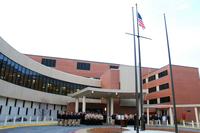Next year, six "safety-critical" parts on a number of the Marine Corps' most in-demand rotorcraft will be 3-D printed as the Navy demonstrates the value of cutting-edge additive manufacturing technology.
In a Naval Aviation Vision roadmap document released this month, Naval Air Systems Command officials said they planned to 3-D print and field parts for the MV-22B Osprey, the new CH-53K King Stallion, which is still in the early phases of production, and the H-1 Marine Corps Light/Attack Helicopters, including the AH-1Z Viper.
"The safety-critical [additive manufacturing] parts fielded on these platforms will allow NAVAIR to develop the processes and digital data standards needed to extend [additive manufacturing] to other classes of parts and components," officials said in the document.
Two metal parts will be printed for each of the three aircraft platforms, Liz McMichael Naval Air Systems Command's Additive Manufacturing/Digital Thread Integrated Product Team lead, told Military.com via email. They are as follows:
-- MV-22 Osprey: Titanium engine nacelle link and stainless steel lever for the fire extinguishing system
-- H-1 helicopters: Upper uni-ball suppressor support and engine mount apex fitting, both stainless steel
-- CH-53K King Stallion: Clevis latch and lug latch, both titanium
In a second set of planned demonstrations, parts will also be printed for the Marines' workhorse CH-53E Super Stallions and AV-8B Harriers, said Hart. The parts to be manufactured and fielded in that demonstration for the Super Stallion include a titanium engine brace and a ball fitting in stainless steel, she said.
The Navy is partnering with Penn State Applied Research Lab for the additive manufacturing demos, Hart said. The parts for the aircraft were produced there and at the Naval Air Warfare Center Aircraft Division in Lakehurst, New Jersey.
"As we develop our standards and understand how to ensure quality using [additive manufacturing] processes, we want to work with industry to enable them to make these parts," McMichael said. "We need to develop a broad industry base that understands how to make [them] safely."
Ultimately, the Navy aims to use additive manufacturing processes much more in aviation, allowing maintainers and logisticians more flexibility in the repair and upkeep of aircraft. Already, according to the aviation roadmap, 3-D printing has allowed the Navy to
In June 2014, NAVAIR technicians in Cherry Point, North Carolina, used 3-D printed tools to fix a Harrier that damaged the frame of its nose cone during a hard landing on the amphibious assault ship USS Bataan. Thanks to this technology, replacement parts were delivered to the aircraft within seven days, according to the roadmap document.
In another example, technicians at the Navay Air Warfare Center Aircraft Division in Lakehurst were able to 3-D print a custom wrench that allowed them to change the oil on an H-60 Seahawk helicopter without removing the transmission, an improvement that saved 80 work hours for each oil change.
The new technology, officials said in the document, allows the Navy to "stock the data, not the part," reducing supply timelines, enabling faster maintenance and repairs and reducing packaging, handling, storage and transportation costs.








